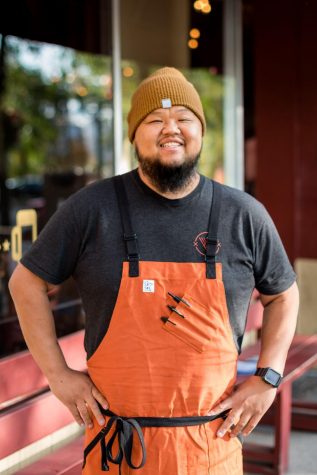Posted on 16 March 2021.
A lamp post near the University Avenue and 12th Street bus stop is stamped with a circular blue and red sticker with a white “F” in the center. Students, staff and locals walk past this unassuming light post, sometimes not thinking much of it — maybe not even noticing the sticker’s existence — but those who have taken note are curious.
Is it a cult’s symbol? Is it the product of a design student’s final project? Drew Kinkade, founder of Flavor World, is the answer.
The stickers are just one of Kinkade’s many machinations for his brand. With a YouTube channel with over 40,000 subscribers, a clothing brand that sells hand-printed tees with the Flavor World logo on them and a studio full of his art, Kinkade is a college dropout turned modern creative.
Switching gears
In the fall of 2016, Kinkade enrolled as a student at the University of Minnesota. Two years into his engineering degree, he decided to drop out.
He didn’t want to do hours of engineering homework. He didn’t want to go to job fairs. For Kinkade, his degree was something he wanted to get over with.
“I was at a point where engineering was kind of like the bland side of life where I didn’t want to do it,” Kinkade said. “But this other stuff — drawing and putting it on T-shirts and selling it to my friends — that was, like, super interesting, and I really, really wanted to do that.”
Thus, Flavor World was born. He got to work on his company, beginning collection releases of custom-designed hats, shirts and other merchandise.
Kinkade was always a doodler. On his notes at school, on his college engineering homework, on his friend’s basement walls or on his family’s cement basement floors, words and scribbles of his always made their way onto whatever drawable surface he could touch. His Flavor World stickers found all over the city are another extension of this artistic footprint.
“If we’re hanging out, walking around the city, he just has [the stickers] in his pocket always,” his friend and fellow artist Mary Moonbeam said. “He’ll just put them in random places.” And he’ll encourage his friends to do the same.
You can find the stickers all around the Twin Cities but travel outside of the state of Minnesota, and you still might happen upon a sticker elsewhere. With friends and fans of the brand in Wisconsin, you may just find yourself seeking out the stickers on other college campuses like the University of Wisconsin-Madison or Eau Claire.
Kinkade’s mom, Kathy Young, remembers putting the stickers in random places during a family vacation to Hawaii.
“It started with putting stickers on stop signs at the U or a bus shelter downtown or something like that. And then there’d be strangers that would be like, ‘Oh yeah, I saw your sticker,’ and we thought it was so cool that this guy just said he saw our sticker. And now it’s like 4 million people are watching his videos. … We used to think it was really cool when someone mentioned they saw a sticker,” she said.
After Kinkade got into rug tufting in November of 2020, the Flavor World YouTube channel began to take off. His most viewed video on the channel, a rug tufting ASMR — autonomous sensory meridian response — video that’s 58 seconds long and shows himself tracing and tufting a rainbow- and cloud-outlined mirror, garnered over 5.5 million views to date.
He’s also a religious journaler. On an average day, he dedicates a few hours to writing down his thoughts. “A lot of my time each day is spent just sitting down with a blank piece of paper in front of me,” he said.
Kinkade began journaling around a year and a half before the idea for the brand came into his head. His collection of journals spans years, and within the many journals and pages are the first ideations and hopes for his brand.
“It’s all on paper. Just, like, everything that has to do with anything,” Kinkade said
It’s been a year since he dropped a new apparel collection, but Kinkade is working on a collection slated to drop in late March or early April that will feature new shirts, hoodies and a few new rugs.
“It’s gonna be amazing,” CJ Springett, his friend who’s helped with the new collection’s website development, said. According to Springett, Kinkade has always held collaboration as a core identity. “He loves working with other creators, and I don’t see that changing ever,” he said.
“I hope to do a lot more than just clothing, too,” Kinkade said. “I want to try and touch as many creative art forms as I possibly can.” A magazine, a record label, a movie theater, a restaurant; to Kinkade, nothing is out of the question for Flavor World.
“It’s been super awesome to have the YouTube channel take off just a couple months ago. It’s still very new and still in progress. I’m just trying to keep that in motion,” he said.
‘Mistakes don’t exist’
David Smith, a self-described digital nomad, met Kinkade one summer night in Chicago after their friends decided to Uber home. Smith, a staunch opponent of Uber, decided to walk home instead. Kinkade joined Smith and on their hour-long walk, they immediately became friends, divulging into conversations on art and philosophy.
In Kinkade’s studio, there’s a note-to-self on his mirror to call his friends more.
Smith and Kinkade have only met each other in person twice, but they call each other frequently and talk about creative motivation, brand ideation and anything else that happens to be on their minds that day. But normally, “Motivation and art are the two things that fit into every single phone call,” Smith said. Flavor World is usually at the center of the conversation.
“His motivation to create something so that other people can create more is just like the best motivation for building a brand that I have heard,” Smith said.
Behind Flavor World is a guy who doesn’t take his art too seriously and exists to create things or inspire others to create, whether in the form of clothing, paintings or rugs.
“The thing is I get so much, like, not just satisfaction but, like, personal development and growth just from creating things and making art and stuff, so I really try to make that a big part of the brand,” Kinkade said. “Inspiring others and trying to show people it’s, you know, it’s okay to make things. I think more people should be chasing the arts; I think there’s a way to make it work.”
In one of his Youtube videos, titled “Mistakes Dont Exist,” Kinkade greets the viewers with a “Yoooo what’s up” and then walks viewers through his process of painting a piece.
“Going through the process I kept making mistakes, and I was getting really frustrated, but I used it as a lesson for myself and hopefully a lesson for you as well that mistakes don’t exist,” he said to the camera.
Lo-fi music plays in the background as Kinkade covers a canvas with an assortment of colors. White skeletons and skulls begin to populate the canvas and then he covers them with black and blue paint. “I roll with the mistakes; I roll with the layers. … I never woulda had this group of skele-dudes on top if I never woulda messed up the layering on the bottom,” Kinkade said in the video.
The final product is a funeral after-party with skeletons in colorful hats and crowns crowding around a dead skeleton’s grave. “When you die and everyone’s all sad at your funeral and then everybody leaves, that night all the fellow skeletons there all turn up. You all have a party; they’re all happy that you’re there. … It’s the funeral after-party,” Kinkade said in the video.
“His brand integrity is everything,” Sage Young, a local artist and fan of the brand, said. Kinkade helped Young with his music video for free, imploring Young to put all of the money into the video instead of paying Kinkade for his video services.
The magic trick
In Flavor World’s studio on Como Avenue in St. Paul, pastel-colored rugs lie on the ground near his artwork corner. Kinkade’s color palette relies on a pleasing assortment of light blues, light pinks and yellows.
One painting he made hangs on his wall and stands out from the rest. The bubblegum pink canvas displays the words “99,999 more to go” above a skeleton smoking a cigarette as its skull explodes. Kinkade painted this to remind himself of how much art you have to make to get to where you want to be.
“I’ll never sell my paintings. … It’s just weird to put a price on them. A shirt has a function, and the price of shirts is an established number,” he said. But with art, one painting could go for any given price, depending on what the buyer values it for. “It’s entirely subjective, and it doesn’t matter at all.”
For someone with little technical art experience, Kinkade views his artwork as more conceptual — like putting stickers around a city — rather than technical and rigorous works.
Kinkade describes his style as a combination of Andy Warhol’s and Jean-Michel Basquiat’s. Warhol’s art opened up the idea that art can exist as an idea rather than a technically impressive piece.
“Someone could easily reproduce my work — it’s not that impressive of a work. It’s just the idea that’s impressive,” he said.
And what about those stickers? How did they end up all over the Twin Cities? According to Kinkade, the operation was “completely calculated.” To Kinkade, the idea of putting nondescript stickers around a city feels like a magic trick. “The fun part of a magic trick is not knowing how it’s done” — or who’s behind it.
He could have added a website link to the sticker and generated more web traffic and merchandise sales, but that’s not as fun, Kinkade said.
“He could actually probably make decent money, but his pricing of his stuff is just so low,” friend and photographer Sawyer Brice said. “He’s sold paintings that are probably worth $200 for $10, and I can’t get him to make them more expensive.”
This past fall, Brice, an Eau Claire-based photographer and director, orchestrated an art pop-up and invited Kinkade to sell some pieces. At the pop-up, Kinkade wouldn’t sell his paintings for more than $20, according to Brice.
“I would always look over at him like ‘you’re crazy,’ but I respect it,” Brice said. Kinkade sold Brice one of his paintings for cheap. Whenever friends visit, they’ll compliment Kinkade’s artwork.
The painting hangs in the corner of Brice’s room. On the canvas, dull skyscrapers hover in front of a magenta sky. In the center of the painting, “Welcome to Bland Land” is painted in bold cursive. In response to the compliment, Brice will tell them, “Yeah, I got it for ten dollars.”


